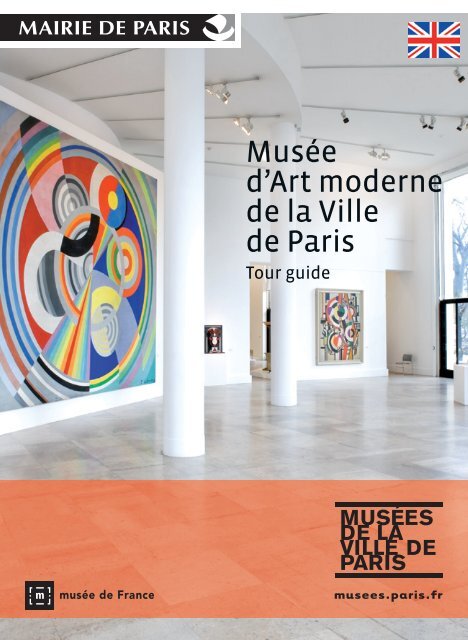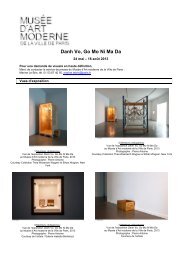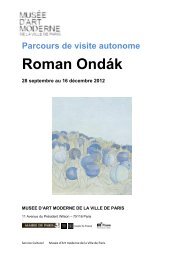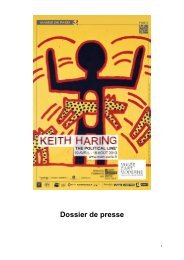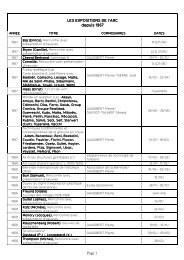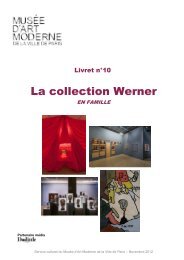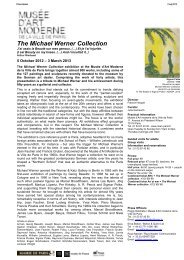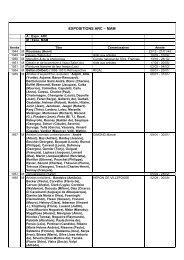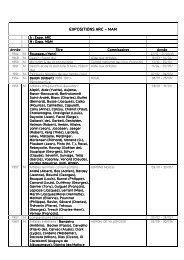A guide to the collection - Musée d'Art Moderne - Ville de Paris
A guide to the collection - Musée d'Art Moderne - Ville de Paris
A guide to the collection - Musée d'Art Moderne - Ville de Paris
Create successful ePaper yourself
Turn your PDF publications into a flip-book with our unique Google optimized e-Paper software.
<strong>Musée</strong><br />
d’Art mo<strong>de</strong>rne<br />
<strong>de</strong> la <strong>Ville</strong><br />
<strong>de</strong> <strong>Paris</strong><br />
Tour <strong>gui<strong>de</strong></strong><br />
MUSÉES<br />
DE LA<br />
VILLE DE<br />
PARIS<br />
musees.paris.fr<br />
MUSÉES<br />
DE LA
A<br />
B<br />
1<br />
2<br />
3<br />
4 à 7<br />
8<br />
2<br />
3<br />
4<br />
7<br />
Detailed plan of <strong>the</strong> permanent <strong>collection</strong>s<br />
(Level -2)<br />
Staircase <strong>to</strong> <strong>the</strong> Matisse Gallery and Dufy Gallery<br />
Staircase <strong>to</strong> <strong>the</strong> Boltanski Gallery and Noire Gallery<br />
Galleries with disabled access:<br />
1, 2, 3, 8 - 12bis, 16, 17, 17 bis<br />
A general plan of <strong>the</strong> museum<br />
can be found at <strong>the</strong> end<br />
of <strong>the</strong> leaflet<br />
B<br />
11<br />
5<br />
6<br />
1<br />
12<br />
Fauvism and Cubism<br />
Abstraction-Creation<br />
Decorative arts<br />
Surrealism<br />
The <strong>Paris</strong> School<br />
10<br />
8<br />
12bis<br />
9<br />
17bis<br />
8<br />
A<br />
13<br />
17<br />
16<br />
14bis<br />
A<br />
14<br />
16<br />
9 Realist art<br />
10 Abstract art<br />
11 Étienne-Martin Collection<br />
12 Eugène Leroy<br />
12 bis New Realism<br />
13 à 17 bis Contemporary art <strong>to</strong>ur<br />
15<br />
Presentation<br />
A <strong>gui<strong>de</strong></strong> <strong>to</strong><br />
<strong>the</strong> <strong>collection</strong><br />
The City of <strong>Paris</strong> Museum of Mo<strong>de</strong>rn Art was officially<br />
opened in 1961 in <strong>the</strong> East Wing of <strong>the</strong> Palais <strong>de</strong> Tokyo, built<br />
by <strong>the</strong> architects Don<strong>de</strong>l, Aubert, Viard and Dastugue for <strong>the</strong><br />
1937 International Exhibition.<br />
Donors, collec<strong>to</strong>rs and artists have played a crucial role in<br />
enriching <strong>the</strong> museum <strong>collection</strong>s since its very beginnings.<br />
An exceptional bequest of more than five hundred works<br />
by Dr Maurice Girardin is one of <strong>the</strong> highlights of <strong>the</strong> current<br />
<strong>collection</strong> and inclu<strong>de</strong>s a body of Fauvist paintings, an<br />
important group of Cubist works and numerous works from<br />
<strong>the</strong> <strong>Paris</strong> School. In 1954, Électricité <strong>de</strong> France donated <strong>the</strong><br />
huge mural by Raoul Dufy entitled La Fée Électricité<br />
[The Electricity Fairy]. Donations from Amos (1955) and<br />
Henry-Thomas (1976,1984,1986) also played a <strong>de</strong>cisive part<br />
in establishing <strong>the</strong> museum’s i<strong>de</strong>ntity. The museum has<br />
also received gifts from numerous artists.<br />
Moreover, from 1937, <strong>the</strong> City of <strong>Paris</strong> had already started<br />
<strong>to</strong> acquire major artworks such as The Dance by Matisse.<br />
The museum <strong>collection</strong> based around outstanding works<br />
(Bonnard, <strong>the</strong> <strong>de</strong>corative arts from <strong>the</strong> inter-war era,<br />
Delaunay, Dufy, Fautrier, Rouault, Étienne Martin, etc)<br />
was fur<strong>the</strong>r enriched by groups of work representing<br />
contemporary movements (New Realism, Arte Povera,<br />
Supports/Surfaces, Narrative Figuration, German painting,
Presentation<br />
<strong>the</strong> young French scene, etc.) forming representative<br />
groupings of <strong>the</strong> main figures in contemporary art and<br />
encouraging new artists.<br />
Temporary exhibitions are a fundamental part of <strong>the</strong><br />
museum’s core activities. ARC (<strong>the</strong> contemporary art<br />
<strong>de</strong>partment) provi<strong>de</strong>s a national and international<br />
information service and hosts exhibitions focusing on<br />
a <strong>the</strong>me or single artist <strong>de</strong>signed <strong>to</strong> introduce <strong>the</strong> public<br />
<strong>to</strong> <strong>the</strong> most innovative artistic trends.<br />
The new displays offer a perspective on mo<strong>de</strong>rn and<br />
contemporary art, highlighting major artistic figures who<br />
have perhaps been unjustly overlooked by his<strong>to</strong>ry of art<br />
in recent times. This provi<strong>de</strong>s an opportunity <strong>to</strong> rediscover<br />
paintings by artists ranging from Pascin <strong>to</strong> Valladon and<br />
from Vuillard <strong>to</strong> Dufy working in <strong>the</strong> mo<strong>de</strong>rn style on <strong>the</strong><br />
fringes of <strong>the</strong> avant-gar<strong>de</strong> movements, as well as <strong>to</strong> dwell<br />
on <strong>the</strong> return <strong>to</strong> Realism in <strong>the</strong> 1930s pursued in <strong>the</strong><br />
post-war era by Buffet, and <strong>to</strong> reflect on abstract art born<br />
in <strong>the</strong> 1940s in <strong>the</strong> wake of Surrealism and its relationship<br />
with literature.<br />
Galleries <strong>de</strong>voted <strong>to</strong> figures such as Étienne-Martin and<br />
Eugène Leroy punctuate this <strong>to</strong>ur and offer an opportunity<br />
<strong>to</strong> explore <strong>the</strong>ir highly individual artistic worlds. Lastly, in<br />
keeping with <strong>the</strong> museum’s exhibition policy and its ongoing<br />
interest in <strong>the</strong> international art scene, <strong>the</strong> <strong>collection</strong>s<br />
represent contemporary artists through works by Bridget<br />
Riley and Cerith Wyn Evans, in particular, and <strong>the</strong> medium<br />
Gallery 2<br />
Frank Kupka,<br />
Diagonal<br />
planes, 1925<br />
Étienne Béöthy,<br />
Dominant seven<br />
chords, opus 81,<br />
1938 © ADAGP<br />
Presentation<br />
of vi<strong>de</strong>o art. A large amount of space is also <strong>de</strong>voted <strong>to</strong> <strong>the</strong><br />
<strong>de</strong>corative arts and furniture from <strong>the</strong> 1920s and 1930s,<br />
echoing <strong>the</strong> architecture and origins of <strong>the</strong> museum itself.<br />
The <strong>to</strong>ur follows a route incorporating areas recreating part<br />
of <strong>the</strong> original structure of <strong>the</strong> building. The monumental<br />
galleries look out over courtyards <strong>to</strong> <strong>the</strong> Seine, allowing<br />
natural light <strong>to</strong> come in and establishing a relationship<br />
between interior and exterior space.
André Derain<br />
Three figures<br />
seated on <strong>the</strong><br />
grass, 1906<br />
© <strong>Musée</strong> d’Art mo<strong>de</strong>rne<br />
<strong>de</strong> la <strong>Ville</strong> <strong>de</strong> <strong>Paris</strong> /<br />
Roger-Viollet<br />
© ADAGP<br />
Gallery 1<br />
Permanent <strong>collection</strong>s Permanent <strong>collection</strong>s<br />
Fauvism and Cubism - Gallery 1<br />
The <strong>to</strong>ur begins with Fauvist masterpieces by Matisse,<br />
Derain and Vlaminck and is complemented by a selection<br />
of some thirty ceramic works which are <strong>the</strong> fruit of artists’<br />
collaboration with André Mettey. In <strong>the</strong> same gallery,<br />
works by Picasso, Braque, Fernand Léger and Juan Gris<br />
establish a dialogue with o<strong>the</strong>r strands of Cubism, Gol<strong>de</strong>n<br />
Section and Orphism paintings, of which <strong>the</strong> museum has a<br />
representative <strong>collection</strong>.<br />
Abstraction - Creation - Gallery 2<br />
Robert Delaunay’s Rhythm No. 1 (1938) launched <strong>the</strong> trend<br />
for abstract art in <strong>the</strong> inter-war era, with most artists<br />
belonging <strong>to</strong> <strong>the</strong> Abstraction-Creation group which was an<br />
umbrella for all non-figurative, geometric and biomorphic<br />
art in <strong>the</strong> 1930s.<br />
Pablo Picasso<br />
Dove with green peas, 1911<br />
© <strong>Musée</strong> d’Art <strong>Mo<strong>de</strong>rne</strong> / Roger-Viollet<br />
© Succession Picasso 2009<br />
Gallery 1<br />
Decorative Arts Gallery<br />
Jean Dunand,<br />
Sports, 1935<br />
André Arbus, Suite<br />
of furniture for <strong>the</strong><br />
Society of Interior<br />
Decora<strong>to</strong>rs’ pavilion<br />
at <strong>the</strong> International<br />
Exhibition, 1937<br />
© Pierre An<strong>to</strong>ine<br />
Decorative Arts - Gallery 3<br />
One of <strong>the</strong> monumental galleries overlooking <strong>the</strong> Seine<br />
displays a <strong>collection</strong> of <strong>de</strong>corative art from <strong>the</strong> 1930s<br />
consisting of furniture and objets d’art. Around a painted<br />
panel entitled Sports (1935), created by Dunand for <strong>the</strong><br />
steamship Normandie, is prestigious furniture <strong>de</strong>signed<br />
by Ruhlmann, Printz, Arbus, Chareau and Adnet testifying<br />
<strong>to</strong> <strong>the</strong> City of <strong>Paris</strong>’ commitment <strong>to</strong> classic and mo<strong>de</strong>rnist<br />
<strong>de</strong>corative arts when <strong>the</strong> museum was established.<br />
During <strong>the</strong> 1937 International Arts and Technology<br />
Exhibition, <strong>the</strong> City of <strong>Paris</strong> purchased many high-quality,<br />
lavishly-worked objects from leading ceramicists,<br />
glassworkers, brass workers and metalworkers, which<br />
pushed <strong>the</strong> existing boundaries of form and materials.
Permanent <strong>collection</strong>s Permanent <strong>collection</strong>s<br />
Vic<strong>to</strong>r Brauner<br />
Portrait of Bre<strong>to</strong>n, 1934<br />
© <strong>Musée</strong> d’Art mo<strong>de</strong>rne/ Roger-Viollet<br />
© ADAGP<br />
Gallery 6<br />
Francis Picabia<br />
The Lovers, circa 1924-1925<br />
© <strong>Musée</strong> d’Art mo<strong>de</strong>rne <strong>de</strong> la <strong>Ville</strong> <strong>de</strong><br />
<strong>Paris</strong> / Roger-Viollet © ADAGP<br />
Gallery 4<br />
Dada and Surrealism - Galleries 4, 5, 6 and 7<br />
André Bre<strong>to</strong>n provi<strong>de</strong>s <strong>the</strong> focal point for Surrealism<br />
in this gallery, with works from his studio (donated by<br />
Aube Bre<strong>to</strong>n-Elléouët and Oona Elléouët). Work from his<br />
<strong>collection</strong>, purchased when <strong>the</strong> contents of his studio at 42,<br />
rue Fontaine were sold off in 2003, provi<strong>de</strong>s an insight in<strong>to</strong><br />
some of <strong>the</strong> personalities and high points of <strong>the</strong> movement<br />
- collective exquisite corpses sessions and group exhibitions,<br />
notably <strong>the</strong> 1938 exhibition. These displays are regularly<br />
updated because of <strong>the</strong> fragile nature of <strong>the</strong> works on paper<br />
and pho<strong>to</strong>graphs.<br />
Pierre Bonnard<br />
Nu<strong>de</strong> in <strong>the</strong><br />
bath, 1936<br />
© <strong>Musée</strong> d’Art mo<strong>de</strong>rne<br />
<strong>de</strong> la <strong>Ville</strong> <strong>de</strong> <strong>Paris</strong> /<br />
Roger-Viollet © ADAGP<br />
Gallery 8<br />
Raoul Dufy<br />
30 years or life<br />
in pink, 1931<br />
<strong>Musée</strong> d’Art mo<strong>de</strong>rne<br />
<strong>de</strong> la <strong>Ville</strong> <strong>de</strong> <strong>Paris</strong><br />
© <strong>Musée</strong> d’Art<br />
mo<strong>de</strong>rne/ Roger-Viollet<br />
© ADAGP<br />
Gallery 8<br />
<strong>Paris</strong> School - Gallery 8<br />
The <strong>Paris</strong> School is extremely well represented, with works<br />
by Marc Chagall (The Dream, 1927), portraits by Ame<strong>de</strong>o<br />
Modigliani, Chaïm Soutine, Moïse Kisling, Kees Van Dongen<br />
and Pascin. Masters of in<strong>de</strong>pen<strong>de</strong>nt art such as Henri<br />
Matisse, Raoul (30 years or life in pink, 1931) and Pierre<br />
Bonnard (Nu<strong>de</strong> in <strong>the</strong> Bath, 1936) are displayed in parallel,<br />
recalling <strong>the</strong> crucial role played by colour in <strong>the</strong> French<br />
art scene from <strong>the</strong> inter-war ear.<br />
Ame<strong>de</strong>o Modigliani<br />
Woman with a fan,<br />
Lunia Czechowska, 1919<br />
© <strong>Musée</strong> d’Art <strong>Mo<strong>de</strong>rne</strong> / Roger-Viollet<br />
Gallery 8
(on <strong>the</strong> left)<br />
Jean Fautrier<br />
The Jewish<br />
woman, 1943<br />
© <strong>Musée</strong> d’Art <strong>Mo<strong>de</strong>rne</strong><br />
/ Roger-Viollet<br />
© ADAGP<br />
Gallery 9<br />
(on <strong>the</strong> right)<br />
Jean Degottex<br />
E.T.C IV,<br />
30.03.1967, 1967<br />
© <strong>Musée</strong> d’Art mo<strong>de</strong>rne<br />
<strong>de</strong> la <strong>Ville</strong> <strong>de</strong> <strong>Paris</strong> /<br />
Roger-Viollet<br />
© ADAGP<br />
Gallery 10<br />
Permanent <strong>collection</strong>s Permanent <strong>collection</strong>s<br />
Realist art - Gallery 9<br />
The works on display recreate some of <strong>the</strong> his<strong>to</strong>ry and<br />
character of <strong>the</strong> museum by presenting a meaningful<br />
picture of art in <strong>the</strong> 1930s, in particular acquisitions ma<strong>de</strong><br />
in 1937. This section, <strong>de</strong>dicated <strong>to</strong> Realist art of <strong>the</strong> 1930s<br />
and 1940s, brings <strong>to</strong>ge<strong>the</strong>r works by André Derain,<br />
Marcel Gromaire, Francis Gruber as well as a representative<br />
<strong>collection</strong> of works by Bernard Buffet and Jean Fautrier.<br />
An<strong>to</strong>n Rä<strong>de</strong>rscheidt’s 1928 Self-portrait <strong>de</strong>picts a dreamlike<br />
figure reminiscent of Magical Realism. This major work<br />
from <strong>the</strong> German school of New Objectivity was acquired<br />
for <strong>the</strong> <strong>collection</strong> in 2007.<br />
Abstract art - Gallery 10<br />
A variety of forms of abstract art are displayed here,<br />
including pure abstract action painting (Hans Hartung,<br />
Pierre Soulages, Georges Mathieu) and new forms of graphic<br />
innovation (Jean Degottex, Mark Tobey, Henri Michaux),<br />
with paintings by Vieira da Silva providing a transition<br />
between abstract and figurative styles.<br />
Étienne-Martin<br />
Gallery<br />
Wink, 1970<br />
© Pierre An<strong>to</strong>ine<br />
© ADAGP<br />
Étienne-Martin Collection - Gallery 11<br />
This space displays <strong>the</strong> major gift of fifteen sculptures<br />
by Étienne-Martin ma<strong>de</strong> <strong>to</strong> <strong>the</strong> museum by l’Oréal.<br />
This is complemented by <strong>the</strong> generous gift of a large body<br />
of archive material by Madame Marie-Thérèse Martin-Le<br />
Balc’h. The varied range of formats and materials displayed<br />
covers almost <strong>the</strong> whole of <strong>the</strong> sculp<strong>to</strong>r’s career, illustrating<br />
<strong>the</strong> different major series which marked his progression:<br />
early abstract arts, Dwellings, Games and Roots, salvaged<br />
materials and polychromy.
(on <strong>the</strong> left)<br />
Eugène Leroy<br />
Portrait, 1962<br />
© <strong>Musée</strong> d’Art <strong>Mo<strong>de</strong>rne</strong><br />
/ Roger-Viollet<br />
© ADAGP<br />
Gallery 12<br />
(on <strong>the</strong> right)<br />
Raymond Hains<br />
Saffa, 1964<br />
© Philippe La<strong>de</strong>t /<br />
<strong>Musée</strong> d’Art <strong>Mo<strong>de</strong>rne</strong> /<br />
Roger-Viollet<br />
© ADAGP<br />
Gallery 12 bis<br />
Permanent <strong>collection</strong>s Permanent <strong>collection</strong>s<br />
Eugène Leroy - Gallery 12<br />
The first section presents around ten paintings<br />
by Eugène Leroy, including recent gifts from his sons.<br />
Portraiture, nu<strong>de</strong>s, landscapes and flowers provi<strong>de</strong><br />
<strong>the</strong> artist with <strong>the</strong> necessary structure with which <strong>to</strong><br />
experiment until form is virtually swallowed up by colour.<br />
New Realism - Gallery 12 bis<br />
The second section brings <strong>to</strong>ge<strong>the</strong>r a selection of works<br />
by <strong>the</strong> New Realists, a group of artists attempting <strong>to</strong><br />
re<strong>de</strong>fine <strong>the</strong> relationship between art and reality. Everyday,<br />
urban and industrial objects are incorporated in<strong>to</strong> <strong>the</strong>ir<br />
works, taking <strong>the</strong> form of “snare-pictures” (Spoerri),<br />
accumulation (Arman), <strong>to</strong>rn poster collage (Hains) and<br />
assemblage (Raysse). This selection of works culminates<br />
with a tribute <strong>to</strong> Alain Jacquet.<br />
Contemporary <strong>to</strong>ur - Galleries 13 - 17 bis<br />
The contemporary <strong>to</strong>ur is based around events which<br />
have ma<strong>de</strong> an impact on <strong>the</strong> his<strong>to</strong>ry of <strong>the</strong> museum,<br />
including <strong>the</strong> exhibition Mythologies quotidiennes (1964),<br />
with works by <strong>the</strong> Narrative Figuration movement and<br />
“new his<strong>to</strong>rical painting” (Gallery 13). Gallery 14 exhibits<br />
<strong>the</strong> work by Simon Hantaï, who died in 2008, but whose<br />
enduring creativity is captured in <strong>the</strong> museum’s <strong>collection</strong>.<br />
Gallery 14 bis explores <strong>the</strong> close ties between <strong>the</strong> works of<br />
Jean Dupuy and <strong>the</strong> artists belonging <strong>to</strong> <strong>the</strong> Fluxus group.<br />
Gallery 15 houses paintings by major contemporary artists<br />
including Gerhard Richter, Georg Baselitz and Bernard Frize,<br />
as well as recently acquired work by Chris<strong>to</strong>pher Wool.<br />
Certain artists pursued <strong>the</strong>ir personal path in parallel<br />
<strong>to</strong> <strong>the</strong> major artistic trends, such as Alan Charl<strong>to</strong>n,<br />
Bridget Riley (who featured in a retrospective at <strong>the</strong><br />
museum in 2008), exploring colour and its resonances<br />
in abstract art.<br />
Influenced by Conceptual art, Surrealism and by <strong>the</strong><br />
Situationism of <strong>the</strong> 1960s and 1970s, Cerith Wyn Evans<br />
(Gallery 16) created a <strong>collection</strong> of chan<strong>de</strong>liers recreating<br />
passages from his own private world in <strong>the</strong> form of<br />
Morse co<strong>de</strong>.<br />
Gallery 17 is <strong>de</strong>voted <strong>to</strong> displaying recently acquired<br />
contemporary works showcasing <strong>the</strong> very latest trends.
Bridget Riley<br />
Lilac painting, 2003-2008<br />
© Bridget Riley<br />
Gallery 15<br />
Permanent <strong>collection</strong>s Permanent <strong>collection</strong>s<br />
Simon Hantaï<br />
Enguerrand Quar<strong>to</strong>n,<br />
Meun, 1968-1973<br />
© ADAGP<br />
Gallery 14<br />
Henri Matisse<br />
The Dance of<br />
<strong>Paris</strong>, 1931-1933<br />
© Succession<br />
Henri Matisse<br />
Matisse Gallery<br />
Individually accessible galleries<br />
Dufy Gallery<br />
The former reception room of <strong>the</strong> museum houses <strong>the</strong><br />
huge mural painted by Raoul Dufy for <strong>the</strong> 1937 International<br />
Art and Technology Exhibition. Originally installed in <strong>the</strong><br />
Pavillon <strong>de</strong> la Lumière built by Mallet-Stevens, it <strong>de</strong>picts <strong>the</strong><br />
his<strong>to</strong>ry of electricity through its applications and inven<strong>to</strong>rs.<br />
Matisse Gallery<br />
The Unfinished Dance (1931) and The Dance of <strong>Paris</strong><br />
(1931-1933) comprise two of <strong>the</strong> three versions of <strong>the</strong><br />
mural commissioned from Matisse in 1930 by Doc<strong>to</strong>r<br />
Albert C. Barnes for his foundation in Merion, Pennsylvania.<br />
Abandoning traditional oil on canvas, he invented <strong>the</strong><br />
new technique of using coloured paper cut-outs <strong>to</strong> put <strong>the</strong><br />
finishing <strong>to</strong>uches <strong>to</strong> his work. Buren’s Wall of Paintings<br />
has been installed opposite it. The apse houses alternating<br />
<strong>the</strong>matic or monographic displays of works from <strong>the</strong> Henry-<br />
Thomas <strong>collection</strong> as a tribute <strong>to</strong> <strong>the</strong>se two major donors.
Raoul Dufy<br />
The Electricity Fairy, 1937<br />
<strong>Musée</strong> d’Art mo<strong>de</strong>rne <strong>de</strong> la <strong>Ville</strong> <strong>de</strong> <strong>Paris</strong><br />
© Florian Kleinefenn © ADAGP<br />
Dufy Gallery
Isabelle<br />
Cornaro<br />
Oskar<br />
Fischinger’s<br />
First Dream<br />
© Isabelle Cornaro<br />
courtesy of <strong>the</strong> Balice<br />
Hertling Gallery<br />
Noire Gallery<br />
Permanent <strong>collection</strong>s<br />
Noire Gallery<br />
The spaces which comprise <strong>the</strong> Noire Gallery offer four<br />
different vi<strong>de</strong>o presentations per year, alternating with<br />
projects <strong>de</strong>voted <strong>to</strong> single artists or ARC exhibitions.<br />
Boltanski Gallery<br />
This gallery exhibits a selection of iconic works by<br />
Boltanski tracing <strong>the</strong> evolution of his style. They inclu<strong>de</strong><br />
The S<strong>to</strong>reroom of <strong>the</strong> Children’s Museum I and II, 1989<br />
evoking <strong>the</strong> fragility of memory and life; Shadows Theatre<br />
1984-1997, whose poetic style conjures up <strong>the</strong> danse<br />
macabre of <strong>the</strong> Middle Ages and children’s puppet games,<br />
and Telephone subscribers, 2000, in which thousands of<br />
names listed in telephone direc<strong>to</strong>ries worldwi<strong>de</strong> present<br />
a con<strong>de</strong>nsed version of humanity.<br />
Christian Boltanski<br />
The S<strong>to</strong>reroom of <strong>the</strong><br />
Children’s Museum I and II, 1989<br />
© Chris<strong>to</strong>phe Fouin © ADAGP<br />
Boltanski Gallery<br />
*<br />
*<br />
Information<br />
Cafe<br />
Bookshop<br />
Toilets<br />
Lift<br />
Stairs<br />
Disabled access<br />
*<br />
Partial disabled access
<strong>Musée</strong> d’Art mo<strong>de</strong>rne<br />
<strong>de</strong> la <strong>Ville</strong> <strong>de</strong> <strong>Paris</strong><br />
11, avenue du Prési<strong>de</strong>nt Wilson<br />
75116 <strong>Paris</strong><br />
Tel : +33 (0)1 53 67 40 00<br />
Fax : +33 (0)1 47 23 35 98<br />
www.mam.paris.fr<br />
Getting <strong>the</strong>re<br />
Metro stations:<br />
Alma-Marceau or Iéna<br />
RER station: Pont <strong>de</strong> l’Alma (line C)<br />
Bus lines: 32/42/63/72/80/92<br />
Vélib’ station<br />
(self-service cycle hire):<br />
2, avenue Marceau<br />
Opening hours<br />
Permanent <strong>collection</strong>s /<br />
Temporary exhibitions:<br />
Tuesday <strong>to</strong> Sunday 10 am- 6 pm<br />
(last admissions 5.45 pm)<br />
> Evening opening: Exhibitions<br />
only, Thursday until 10 pm (last<br />
admissions 9.45 pm)<br />
> Closed Mondays and public<br />
holidays<br />
Mairie <strong>de</strong> <strong>Paris</strong> - DIRECTION DES AFFAIRES CULTURELLES COMMUNIC’ART /<br />
Design and plans: Passe Moi le Sel – Cover pho<strong>to</strong>graph: Pierre An<strong>to</strong>ine,<br />
<strong>Musée</strong> d’Art mo<strong>de</strong>rne <strong>de</strong> la <strong>Ville</strong> <strong>de</strong> <strong>Paris</strong> / Roger-Viollet - Robert<br />
Delaunay, Rhythm No.1 ©L&M SERVICES B.V. The Hague 20090903,<br />
Fernand Léger, Discs, ©ADAGP, <strong>Paris</strong> 2009. - November 2009<br />
Admissions<br />
> Free admission <strong>to</strong> <strong>the</strong> permanent<br />
<strong>collection</strong>s<br />
> Admission charge for temporary<br />
exhibitions<br />
Cloakroom<br />
Bulky items must be s<strong>to</strong>red in <strong>the</strong><br />
free cloakroom provi<strong>de</strong>d for <strong>the</strong><br />
exclusive use of museum visi<strong>to</strong>rs.<br />
Museum bookshop<br />
and cafe<br />
There is a museum bookshop.<br />
A cafe offers a varied menu during<br />
museum opening hours<br />
Educational and<br />
Cultural Office<br />
Gui<strong>de</strong>d lecture <strong>to</strong>urs<br />
and children’s workshops.<br />
Information and bookings:<br />
+33 (0)1 53 67 40 80<br />
Friends of <strong>the</strong> Museum<br />
Information and membership:<br />
+33 (0)1 53 67 40 40<br />
lesamis@samamvp.com


